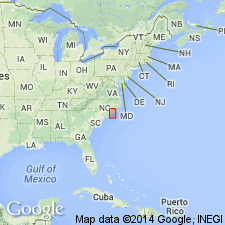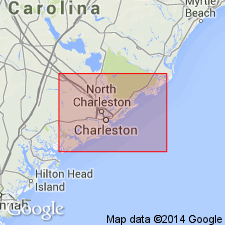
- Usage in publication:
-
- Silverdale Formation
- Modifications:
-
- Named
- Dominant lithology:
-
- Limestone
- AAPG geologic province:
-
- Atlantic Coast basin
Summary:
The Silverdale beds of Vokes (1967) are here named the Silverdale Formation. It lies in a structural basin delineated by the Neuse fault to the northeast and the New River to the southwest and exposures are limited to quarries. The Silverdale represents a downdip offshore facies of the laterally equivalent Belgrade Formation and consists of a basal dense, sandy, pelecypod-mold biomicrudite grading upward into unconsolidated sandy, pelecypod biomicrudite. Disconformably overlies the Trent Formation; disconformably underlies the Crassostrea gigantissima facies oyster channels. Age is early Miocene.
Source: GNU records (USGS DDS-6; Reston GNULEX).

- Usage in publication:
-
- Silverdale Formation
- Modifications:
-
- Age modified
- Overview
- AAPG geologic province:
-
- Atlantic Coast basin
Summary:
Oligocene and lower Miocene stratigraphic nomenclature in NC was revised almost simultaneously by Baum and others (1978) and Ward and others (1978). According to authors, recent studies indicate that neither interpretation is accurate and further revision is necessary. The interpretation presented here is based on a combination of the earlier revisions. The Haywood Landing Member of the Belgrade Formation of Ward and others is equivalent to the Silverdale Formation, which is used here. At its type locality, the Silverdale contains calcareous nannofossils of Zones NP24-25 and therefore is late Oligocene (Chattian) in age.
Source: GNU records (USGS DDS-6; Reston GNULEX).
For more information, please contact Nancy Stamm, Geologic Names Committee Secretary.
Asterisk (*) indicates published by U.S. Geological Survey authors.
"No current usage" (†) implies that a name has been abandoned or has fallen into disuse. Former usage and, if known, replacement name given in parentheses ( ).
Slash (/) indicates name conflicts with nomenclatural guidelines (CSN, 1933; ACSN, 1961, 1970; NACSN, 1983, 2005, 2021). May be explained within brackets ([ ]).

